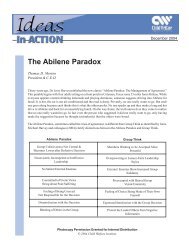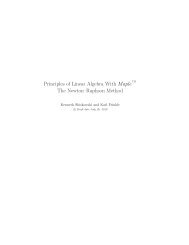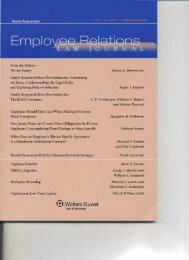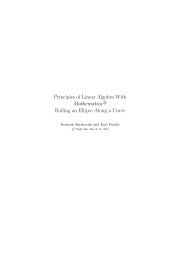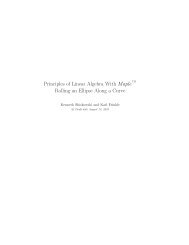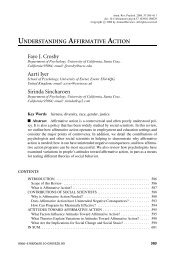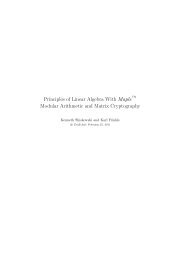Do Nice Guysâand GalsâReally Finish Last - Southeastern ...
Do Nice Guysâand GalsâReally Finish Last - Southeastern ...
Do Nice Guysâand GalsâReally Finish Last - Southeastern ...
Create successful ePaper yourself
Turn your PDF publications into a flip-book with our unique Google optimized e-Paper software.
10 JUDGE, LIVINGSTON, AND HURST<br />
Table 5<br />
Means, Standard Deviations, and Intercorrelations Among Study 3 Variables (Study 3/WLS)<br />
Variable M SD 1 2 3 4 5 6 7 8 9 10 11 12 13 14<br />
1. Education 2.38 0.75 —<br />
2. Married (1 married, 0 <br />
other) 0.67 0.47 .03 —<br />
3. Hours worked per week 50.21 10.43 .14 .00 —<br />
4. Gender (1 male, 2 <br />
female) 1.32 0.47 .22 .19 .15 —<br />
5. Extraversion 3.99 1.05 .01 .01 .15 .09 —<br />
6. Agreeableness 4.75 0.79 .08 .00 .03 .16 .14 —<br />
7. Conscientiousness 4.87 0.80 .04 .02 .07 .04 .14 .18 —<br />
8. Neuroticism 3.03 1.06 .02 .00 .02 .07 .17 .32 .26 —<br />
9. Openness 4.43 0.82 .10 .11 .13 .08 .31 .11 .12 .17 —<br />
10. Unemployment 0.15 2.40 .00 .01 .02 .00 .02 .02 .00 .00 .03 —<br />
11. Continuous work history 1.00 0.07 .05 .01 .02 .06 .02 .03 .00 .05 .01 .00 —<br />
12. Job responsibility 0.38 0.75 .20 .04 .24 .38 .07 .06 .06 .08 .09 .01 .05 —<br />
13. Occupational status 71.62 17.39 .32 .04 .03 .07 .00 .05 .03 .00 .04 .03 .05 .07 —<br />
14. Income 68,111.20 61,658.84 .25 .07 .18 .30 .03 .14 .02 .08 .01 .04 .06 .31 .16 —<br />
Note. WLS Wisconsin Longitudinal Study. N 1,691. Correlations greater than .07 are significant at the .01 level. Correlations greater than .05 are<br />
significant at the .05 level.<br />
able women, this gap almost doubles for disagreeable men and<br />
women. 4<br />
As in Study 2, we included the other four Big Five traits. In<br />
Study 3, the effects of neuroticism replicated those in Study 1,<br />
such that it was a significant predictor of income for men (B <br />
$6,041, p .05) but not for women (B $1,966, p .05).<br />
Extraversion and openness were both not significantly related to<br />
income for men (extraversion B $1,424, p .05; openness B <br />
$2,086, p .05) or for women (extraversion B $2,454, p <br />
.05; openness B $2,808, p .05). Finally, in contrast to Study<br />
2, Conscientiousness was not significantly related to income for<br />
men (B $1,504, p .05) or for women (B $1,646, p .05).<br />
Possible explanations for differential agreeableness–income<br />
relationship by sex. Although the results thus far suggest that<br />
agreeableness is negatively associated with earnings, especially for<br />
men, they do not explain why. Some of the control variables argue<br />
against some possible explanations (i.e., it does not appear that<br />
disagreeable individuals earn more because they occupy more<br />
complex or higher status jobs) but do not suggest where the<br />
explanation may lie. Accordingly, on an exploratory basis, we<br />
investigated two possible explanations. First, disagreeable individuals<br />
may earn more because they value money more than their<br />
more agreeable counterparts. Money motives have been linked to<br />
lower subjective well-being (Kasser & Ryan, 1993; Srivastava,<br />
Locke, & Bartol, 2001), but that, of course, does not address the<br />
question of whether such motives may mediate the relationship<br />
between agreeableness and earnings. Second, agreeable individuals<br />
may earn less because they emphasize friendships (communion)<br />
over economic success (agency; Graziano & Eisenberg,<br />
1997). To be sure, communal relationships may produce tangible<br />
benefits (Grant & Gino, 2010), but there are only so many hours in<br />
a day. It is not always easy to balance communal activities with<br />
agentic ones, and emphasizing communion may come at some cost<br />
to agency (Abele, Uchronski, Suitner, & Wojciszke, 2008).<br />
Accordingly, we measured pay importance with a six-item scale<br />
( .71) assessing the degree to which the individual valued high<br />
pay over other job attributes such as job security, benefits, on-thejob<br />
training, etc. (“Which do you think is more important in a job:<br />
_________ or getting high pay?”). We measured communal relationships<br />
(Crocker & Canevello, 2008) with a four-item scale (<br />
.75) assessing the degree to which the individual was motivated by<br />
and found rewarding their social relationships (“To what extent do<br />
you agree that you enjoy personal and mutual conversations with<br />
family members and friends?”). The pay importance measure was<br />
correlated with gender (r .20, p .01), agreeableness (r <br />
.10, p .01), and income (r .27, p .01), such that those who<br />
valued pay were more likely to be male, to be disagreeable, and to<br />
earn more. The communal relationships variable also was correlated<br />
with gender (r .34, p .01), agreeableness (r .46, p <br />
.01), and income (r .16, p .01), such that women, agreeable<br />
individuals, and those who earned less were more oriented toward<br />
communal relationships. Moreover, entering these two variables in<br />
the regressions specified in Table 6 substantially weakened the<br />
effect of agreeableness on earnings for men. For men, entering the<br />
two variables reduced the agreeableness coefficient from <br />
.15 (p .01) to .08 (p .05). For women, entering the<br />
two variables had little effect on the agreeableness coefficient,<br />
changing it from –.02 (ns) to.03 (ns). Thus, it appears<br />
that the stronger negative effect of agreeableness on earnings for<br />
men can be partly explained by the value disagreeable men place<br />
on earning money over communal relationships.<br />
Paradoxes of agreeableness and gender. A limitation of this<br />
investigation is the focus on a single criterion: income. Though<br />
4 Across the three studies, the Sex Agreeableness interaction term<br />
explained the following incremental variance: Study 1, R 2 .01 (p <br />
.01); Study 2, R 2 .01 (p .01); Study 3, R 2 .02 (p .05).<br />
Although these percentages are low, as noted by Azen and Budescu (2003),<br />
such estimates are not appropriate guides as to the relative importance of<br />
variables within a regression equation. As argued by LeBreton, Ployhart,<br />
and Ladd (2004), a problem with these types of “partial effects” variance<br />
estimates is that they “are not designed to partition the variance shared<br />
between multiple correlated predictors and a criterion” (p. 262) and, thus,<br />
will understate the relative importance of the interaction.



